英语口译笔记
- 格式:docx
- 大小:110.88 KB
- 文档页数:8
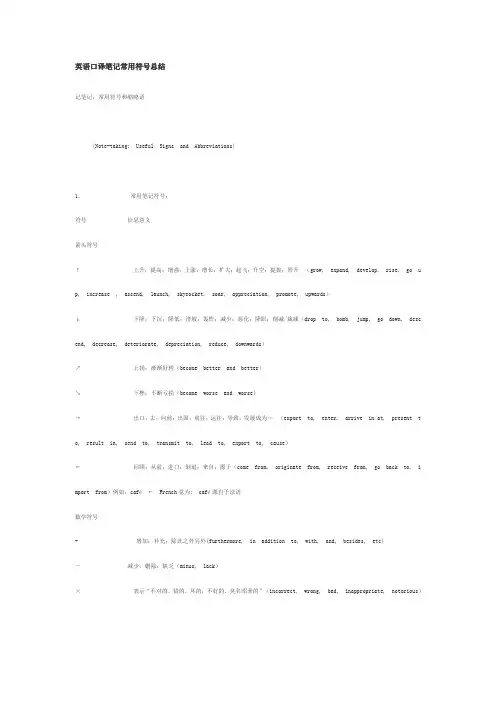
英语口译笔记常用符号总结记笔记:常用符号和缩略语(Note-taking: Useful Signs and Abbreviations)1.常用笔记符号:符号信息意义箭头符号↑上升;提高;增强;上涨;增长;扩大;起飞;升空;提拔;晋升(grow, expand, develop, rise, go up, increase , a scend, launch, skyrocket, soar, appreciation, promote, upwards)↓下降;下沉;降低;滑坡;轰炸;减少;恶化;降职;削减/裁减(drop to, bomb, jump, go down, descend, decrease, d eteriorate, depreciation, reduce, downwards)↗上扬;渐渐好转(become better and better)↘下挫;不断亏损(become worse and worse)→出口;去;向前;出国;前往;运往;导致;发展成为…(export to, enter, arrive in/at, present to, result in, s end to, transmit to, lead to, export to, cause)←回顾;从前;进口;倒退;来自;源于(come from, originate from, receive from, go back to, import from)例如:café← French意为: café源自于法语数学符号+ 增加;补充;除此之外另外(furthermore, in addition to, with, and, besides, etc)—减少;删除;缺乏(minus, lack)×表示“不对的,错的,坏的,不好的,臭名昭著的”(incorrect, wrong, bad, inappropriate, notorious)> 超过,大于,胜过,优于(more than, bigger than, surpass, better than, superior to)< 小于,不足,次于,逊色(fewer than, less than, worse than, inferior to)= 等于符号(equal) 在听力笔记中相当于“与…一样”(equal to, the same as),另外可以表示“是…的对手“(a ri -val, a competitor)等意思。
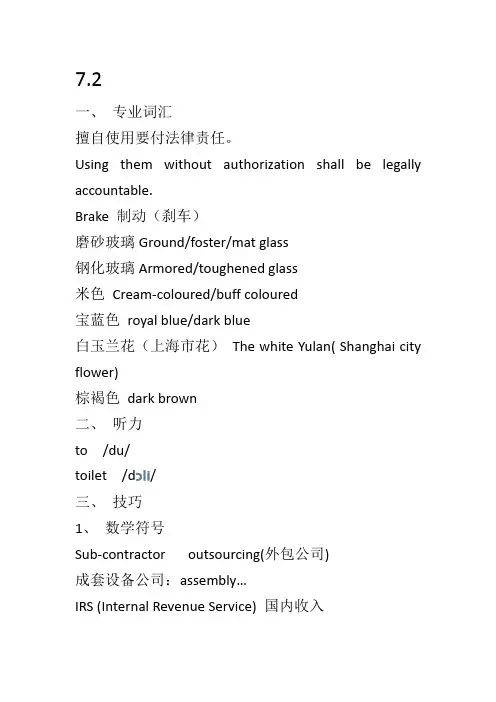
7.2一、专业词汇擅自使用要付法律责任。
Using them without authorization shall be legally accountable.Brake 制动(刹车)磨砂玻璃Ground/foster/mat glass钢化玻璃Armored/toughened glass米色Cream-coloured/buff coloured宝蓝色royal blue/dark blue白玉兰花(上海市花)The white Yulan( Shanghai city flower)棕褐色dark brown二、听力to /du/toilet /dɔli/三、技巧1、数学符号Sub-contractor outsourcing(外包公司)成套设备公司:assembly…IRS (Internal Revenue Service) 国内收入Defense Secretary 外交部长Auto Show=Automobile Industry Exhibition (汽车工业展)2、缩写市政府Municipal People’s Government复婚remarry大力发展generositySS 社会制度CT 文化传统WPD 世界和平发展I’d like to thank sb for kind invitation/thoughtful arrangement/gracious hospitality欢迎某人上台Please join me in welcoming sb onto the stage.We’re very please to have sb with us.3、政治、新闻4、come all the way, 远道而来Conference(文科类的会议)Symposium(理科类的、科技类的研讨会)Seminar (研讨会)Forum (论坛)E.g. … on IT Shanghai 2011 上海2011(国际研讨会)7.9一、口译的Topic应对之策之一:1、Comparison Today I’d like to talk about …2、Opinion Some people thing …3、Other Others believe …4、My opinion …二、口译的Topic应对之策之二:1、Comparison Today I’d like to talk about …2、Achievements3、Problems existing in this field4、Solution三、口译的Topic应对之策之三:1、Comparison Today I’d like to talk about …2、Achievements3、Advantages of doing sth.4、Solution四、Communication1、EQ (Emotion quotient) IQ (intelligence quotient)2、Job vacancy/opportunitiesClear up misunderstandingPromote friendship3、educational background4、healthcare (medical professionals, cities)5、science, technology, pollution6、family, marriage, divorce五、日常知识Tap tops 手提电脑岗前培训:Pre-employment trainingPersonality training 仪表仪容培训进修:Further study儿童医学Pediatrics亲和力winning personality影响shape (customer requirement)“非常好的四金”attractive/competitive benefit/remunerations([ri͵mju:nə'rei∫ən])/package/healthcare system养老保险retirement and pension plan住房公积金public(housing) reserve fund补充公积金fringe benefits补贴subsidyPosition/business travel subsidy 职位津贴、出差补贴Cheese 笑Annuity 年金Your Excellency, the president如果本人不在现场,就用Her majesty, the QueenHis Highness, the Duke… (皇室成员)Your honor, the city mayor of…十月的北京,万木葱茏,金凤送爽。
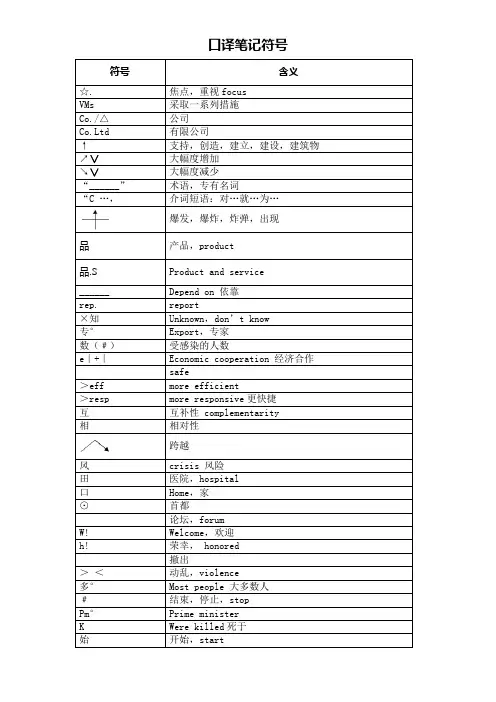
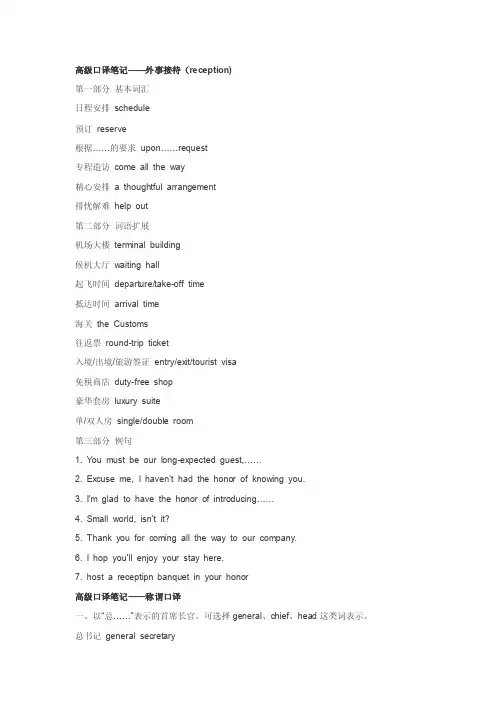
高级口译笔记——外事接待(reception)第一部分基本词汇日程安排schedule预订reserve根据……的要求upon……request专程造访come all the way精心安排a thoughtful arrangement排忧解难help out第二部分词语扩展机场大楼terminal building候机大厅waiting hall起飞时间departure/take-off time抵达时间arrival time海关the Customs往返票round-trip ticket入境/出境/旅游签证entry/exit/tourist visa免税商店duty-free shop豪华套房luxury suite单/双人房single/double room第三部分例句1. You must be our long-expected guest,……2. Excuse me, I haven't had the honor of knowing you.3. I'm glad to have the honor of introducing……4. Small world, isn't it?5. Thank you for coming all the way to our company.6. I hop you'll enjoy your stay here.7. host a receptipn banquet in your honor高级口译笔记——称谓口译一、以“总……”表示的首席长官,可选择general、chief、head这类词表示。
总书记general secretary总工程师chief engineer总会计师chief accountant总经理general manager总代理general agent总教练head coach二、一些行业的职称头衔,直接用“高级”或“资深”来表示,可用"senior"来称呼。
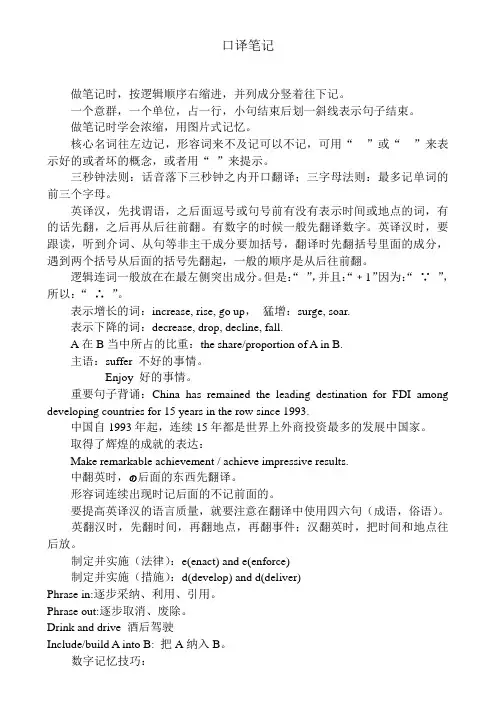
口译笔记做笔记时,按逻辑顺序右缩进,并列成分竖着往下记。
一个意群,一个单位,占一行,小句结束后划一斜线表示句子结束。
做笔记时学会浓缩,用图片式记忆。
核心名词往左边记,形容词来不及记可以不记,可用“”或“”来表示好的或者坏的概念,或者用“”来提示。
三秒钟法则:话音落下三秒钟之内开口翻译;三字母法则:最多记单词的前三个字母。
英译汉,先找谓语,之后面逗号或句号前有没有表示时间或地点的词,有的话先翻,之后再从后往前翻。
有数字的时候一般先翻译数字。
英译汉时,要跟读,听到介词、从句等非主干成分要加括号,翻译时先翻括号里面的成分,遇到两个括号从后面的括号先翻起,一般的顺序是从后往前翻。
逻辑连词一般放在在最左侧突出成分。
但是:“”,并且:“﹢1”因为:“∵”,所以:“∴”。
表示增长的词:increase, rise, go up,猛增:surge, soar.表示下降的词:decrease, drop, decline, fall.A在B当中所占的比重:the share/proportion of A in B.主语:suffer 不好的事情。
Enjoy 好的事情。
重要句子背诵:China has remained the leading destination for FDI among developing countries for 15 years in the row since 1993.中国自1993年起,连续15年都是世界上外商投资最多的发展中国家。
取得了辉煌的成就的表达:Make remarkable achievement / achieve impressive results.中翻英时,の后面的东西先翻译。
形容词连续出现时记后面的不记前面的。
要提高英译汉的语言质量,就要注意在翻译中使用四六句(成语,俗语)。
英翻汉时,先翻时间,再翻地点,再翻事件;汉翻英时,把时间和地点往后放。
制定并实施(法律):e(enact) and e(enforce)制定并实施(措施):d(develop) and d(deliver)Phrase in:逐步采纳、利用、引用。
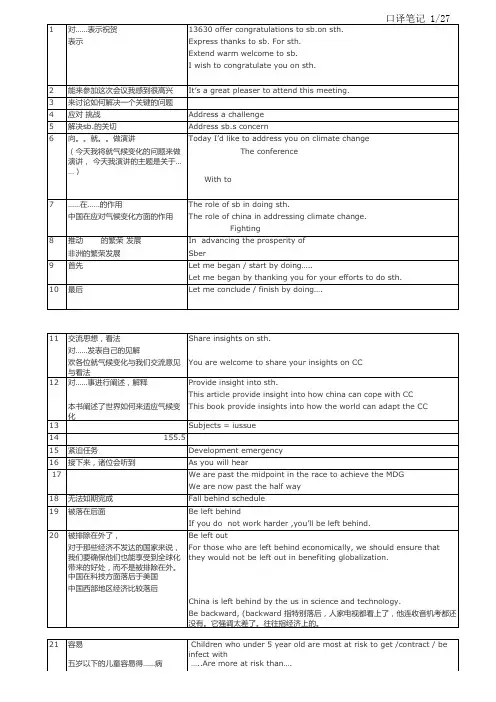

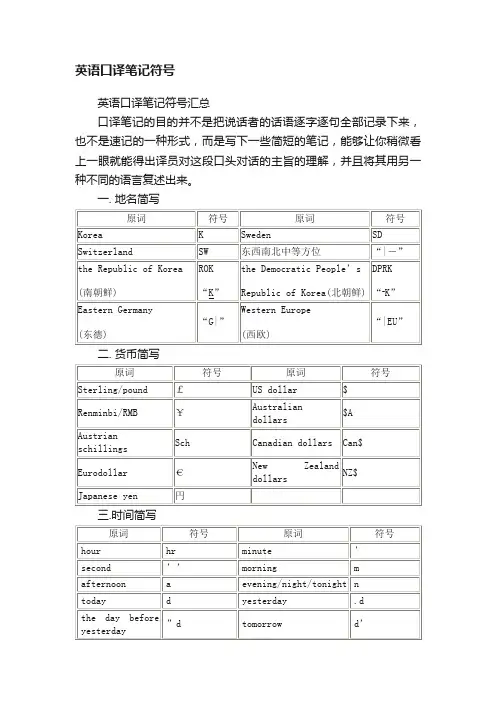
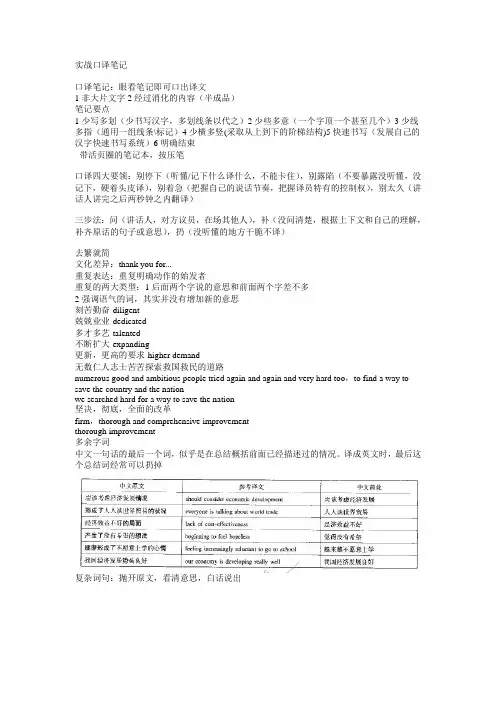
实战口译笔记口译笔记:眼看笔记即可口出译文1非大片文字2经过消化的内容(半成品)笔记要点1少写多划(少书写汉字,多划线条以代之)2少些多意(一个字顶一个甚至几个)3少线多指(通用一组线条\标记)4少横多竖(采取从上到下的阶梯结构)5快速书写(发展自己的汉字快速书写系统)6明确结束带活页圈的笔记本,按压笔口译四大要领:别停下(听懂/记下什么译什么,不能卡住),别露陷(不要暴露没听懂,没记下,硬着头皮译),别着急(把握自己的说话节奏,把握译员特有的控制权),别太久(讲话人讲完之后两秒钟之内翻译)三步法:问(讲话人,对方议员,在场其他人),补(没问清楚,根据上下文和自己的理解,补齐原话的句子或意思),扔(没听懂的地方干脆不译)去繁就简文化差异:thank you for...重复表达:重复明确动作的始发者重复的两大类型:1后面两个字说的意思和前面两个字差不多2强调语气的词,其实并没有增加新的意思刻苦勤奋-diligent兢兢业业-dedicated多才多艺-talented不断扩大-expanding更新,更高的要求-higher demand无数仁人志士苦苦探索救国救民的道路numerous good and ambitious people tried again and again and very hard too,to find a way to save the country and the nationwe searched hard for a way to save the nation坚决,彻底,全面的改革firm,thorough and comprehensive improvementthorough improvement多余字词中文一句话的最后一个词,似乎是在总结概括前面已经描述过的情况。
译成英文时,最后这个总结词经常可以扔掉复杂词句:抛开原文,看清意思,白话说出权衡英文习惯口译平衡尺度:中文习惯,英文习惯把握平衡的原则:a目标听众/读者b原文/原讲话人预期达到的效果c你作为翻译的定位d 交给你的翻译任务e本次笔译或者口译任务的性质(客户目的和译者定位)使用第一人称a谈话内容和场合越正式,越需要讲话人的第一人称“我”b如果译员同时服务于多名讲话人,就可能不得不用讲话人的名字,职称,或称号来区分那段话是谁说的c如果两个人热烈交谈,说话不长,你一句,我一语,也只能用第一人称d在把握不准的时候,也应该用第一人称“我们”以某公司或组织机构的身份发言借用同传技能:分脑技能:兼顾听讲,理解,(笔记)翻译,表达断句:按顺序,分段处理三字诀:顺,补,加顺着译,补语气,加解释two ballons were floating across the desert.One balloon said to the other:"Look out for the cactusssssssss!"三方两面交流与讲话人交流,与听众交流,a尊重b注意力c信心d反馈声音和口才使用不同的声音口才:大众之前的表演;说三法“张口说三”如何处理讲稿:视译,熟悉全文,查阅关键生词,商讨额外收费口译人际关系:双方译员(分工),己方(雇主,客户首要人物,客户决策人物,客户其他人物),对方(对方首要人物,对方决策人物,对方其他人物)接受口译任务a接受任务任务性质:翻译类型,客户,场合,听众,主题内容或者行业,意图,有无稿件,是否有必要与客户见面交代,有问题与谁联系,向谁报告相关事项:时间,地点,人,通行证,报酬(货币:发票,支票,转账,币种),旅行和饭店预订,有无接待,最佳交通方法,三餐b事前准备准时,提前是到十五分钟,装备c当天发挥d任务后的任务自我评估,自我改进职业技能组合:沟通联络,桌前调研,行程安排,紧跟主要讲话人,临场以及意外情况的应付如何准备简历自由职业口译口译interpreting:译员在听取源语后source language,通过口头表达的方式以目标语target language向听众传达讲话人的意思,在语言上无法互通的异语双方或多方之间通过译员的传译能够进行交流沟通。
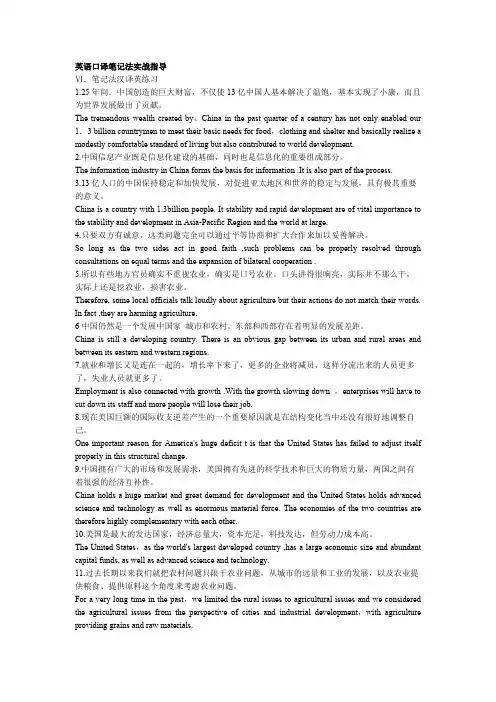
英语口译笔记法实战指导Ⅵ.笔记法汉译英练习1.25年间.中国创造的巨大财富,不仅使13亿中国人基本解决了温饱,基本实现了小康,而且为世界发展做出了贡献。
The tremendous wealth created by、China in the past quarter of a century has not only enabled our 1.3 billion countrymen to meet their basic needs for food,clothing and shelter and basically realize a modestly comfortable standard of living but also contributed to world development.2.中国信息产业既是信息化建设的基础,同时也是信息化的重要组成部分。
The information industry in China forms the basis for information .It is also part of the process.3.13亿人口的中国保持稳定和加快发展,对促进亚太地区和世界的稳定与发展,具有极其重要的意义。
China is a country with 1.3billion people. It stability and rapid development are of vital importance to the stability and development in Asia-Pacific Region and the world at large.4.只要双方有诚意,这类问题完全可以通过平等协商和扩大合作来加以妥善解决。
So long as the two sides act in good faith ,such problems can be properly resolved through consultations on equal terms and the expansion of bilateral cooperation .5.所以有些地方官员确实不重视农业,确实是口号农业。
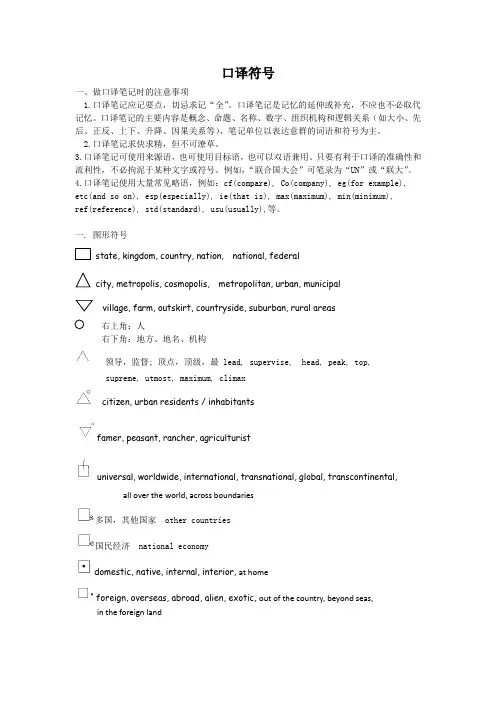
口译符号一、做口译笔记时的注意事项1.口译笔记应记要点,切忌求记“全”。
口译笔记是记忆的延伸或补充,不应也不必取代记忆。
口译笔记的主要内容是概念、命题、名称、数字、组织机构和逻辑关系(如大小、先后、正反、上下、升降、因果关系等),笔记单位以表达意群的词语和符号为主。
2.口译笔记求快求精,但不可潦草。
3.口译笔记可使用来源语,也可使用目标语,也可以双语兼用。
只要有利于口译的准确性和流利性,不必拘泥于某种文字或符号。
例如,“联合国大会”可笔录为“UN”或“联大”。
4.口译笔记使用大量常见略语,例如:cf(compare), Co(company), eg(for example), etc(and so on), esp(especially), ie(that is), max(maximum), min(minimum),ref(reference), std(standard), usu(usually),等。
一. 图形符号state, kingdom, country, nation, national, federalcity, metropolis, cosmopolis, metropolitan, urban, municipalvillage, farm, outskirt, countryside, suburban, rural areas右上角:人右下角:地方、地名、机构领导,监督; 顶点,顶级,最 lead, supervise, head, peak, top,supreme, utmost, maximum, climaxcitizen, urban residents / inhabitantsfamer, peasant, rancher, agriculturistuniversal, worldwide, international, transnational, global, transcontinental, all over the world, across boundaries多国,其他国家 other countries国民经济 national economydomestic, native, internal, interior, at homeforeign, overseas, abroad, alien, exotic, out of the country, beyond seas,in the foreign landin and out of the country, at home and abroad进口 import出口export进出口import & export飞行员pilot飞机场airport中国人Chinese people广场 square, plaze经济实体 economic entity金融机构 financial institutionboss, leader, chairman, ruler, chief, manager, president, majesty, governor,director,supervisor, monitor国家领导人,政府首脑state leader宏观调控,macro-control首都 capital city1.重要important, significant, key, critical, crucial, essential, vital, eventful,principal, core, of great importance,significance/ consequence2. 杰出 great, well-known, outstanding, remarkable, excellent, perfect,brilliant, distinguished, notable, eminent, promising, prominent, prestigious, glorious, noteworthy,3. 主要 main, chief, primary, major, dominant, overwhelming4. 精彩 wonderful, terrific, splendid, fantastic, marvelous5. 强调 emphasize, focus, underline, underscore stress, highlight, spotlight, Accentuate focus on, lay emphasis/stress on attach importance to,pay attention to/the most important1.特点,特色,特征;mark, feature, character, symbol;sign, characteristic, speciality;peculiarity, attribute2. 代表represent, symbolize, typify, stand for, on behalf of1.整体,全部,总共whole, all, total, entire, complete, overall general, universal, integral,gross, intact,on the whole, all in all2. 团结,统一,团聚united, unification, gather, get together所有国家所有人,人民群众主权和领土完整sovereignty and territorial integrity⊙会议meeting, forum, session, seminar, conference, symposium, committee,association, parliament, council峰会summit (meeting)1.关联link to, connect with, relate to, associate with2. 替replace, displace, supplant, substitute instead of, take the place of∞ 1.交流,交换exchange, interact, communicate2. 关系interaction, relation, relationship Partnership双边关系,bilateral relationship多边关系,multilateral relationship举杯,协议toast, agreement, treaty, contract Convention, revolution双边协议,bilateral agreement多边协议,multilateral agreement发展,develop, development发达的,developed发展中的,developing⊕1. 开始begin, start, initiate, open originate, launch, pioneer commence, inaugurate2. 形成,产生,出现establish, found, create, appear, emerge, occur, come out, break out,come into being / existence3. 医疗卫生Red Cross, hospital, medical care medical institution禁止、结束end, conclude, complete, cease, stop, close, terminate, expire, halt, over,pause, turn off, switch off, break up make an end of, bring to an end,bring to a conclusion道路,方法method, way, road, means, measureapproach, manner, access, route, course mode, by means of, by way of1.歪曲twist, distortion of fact2. 困难,挫折difficulty, hardship, trouble, painful, tough, frustration, setback远far away近near, close台阶,进步step by step, progress, advance make progress过去,历史in the past, history昨天yesterday上个月last month去年last year前所未有的,unprecedented很久以前,long before未来,将要, in the future改变,变化change, transform果实,成果fruit, result, accomplishment achievement1.(使)消失,废除delete, exclude, dismiss, erase disappear, vanish, extinct, removeabolish, get rid of, wipe out2. 破坏,推翻,剥夺destroy, ruin, collapse, overthrow demolish, deprive,3. 抛弃abandon, desert, discard4. 倒闭,下岗bankrupt, lay off, resign, retire5. 死亡,已故的kill, murder, die, pass away, the late6. 解决,达到,实现overcome, settle, solve, address, realize, achieve, accomplish, fulfill二. 人体行为符号smile, happy, glad, pleased, excited in a good moodunhappy, sad, unsatisfied, angry, in a bad moodQ 1. 说tell, state, announce, express, claim, address, declare, argue, vow,explain, Introduce, report2. 评论comment, remark, evaluate appraise, review开罗宣言,Cairo Manifesto赞扬 speak highly of, praise批评 criticize众说纷纭,若干说法various opinions1. 听, listen to2. 开放, be open to改革开放reform and opening up爱,关心love, concern, care aboutscare, threaten: 1.看observe, view, glance, stare, notice glimpse, scan, skim, witness, gaze2.想think, consider, regard, conceive ponder, suppose, imagine, meditate speculate,contemplate3. 揭示,显示show, suggest, indicate, reveal, discover, reflect←1. 来come 2. 收到receive 3. 需要,缺少need, require, want, be short of,4. 邀请,应邀invite, on invitation愿意接受accept with pleasure1. 卖sell2. 获利make a profit1.去,到 go2.引起,导致result in, lead to1.买buy2. 投资invest↑增加;上升;完善;繁荣increase, heighten, enhance, grow, lift soar, rise, raise, elevate, ascend flourish, advance, update, improve prosperity, boost, give boost to, go up↓减少,降低,贬值decrease, decline, reduce, descend diminish, fall, drop, sink, lower relieve, weaken, lessen, deteriorate devalue, degrade, depreciate, discount go down, fall off1. 很,非常deeply, very, quite, awfully2. 深远的profound, far-reaching推动,促进,有助于promote, strengthen, encourage stimulate, facilitate, reinforce strive, push, urge, stir, force accelerate, drive, prompt, propel give impetus to, carry forward阻碍,推迟obstacle, postpone, delay, restrain withdraw, discourage, curb, hamper hinder,barrier, bar, encumber, put off stand in one’s way, hold back, draw back冲突,矛盾,分歧,争议conflict, contradiction difference, dispute↗越来越increasing, growing, more and more越来越大bigger and bigger越来越多more and more压力,影响pressure, burden, load, stress, impact, influence, effect, affect exert influence on, have effect on迄今为止so far, up to now, till now四. 标点符号…1.多numerous, countless, enormous abundant, various, mass, uncountableinnumerable, considerable, substantial a series of2.持续,继续,一直last, continue, remain, maintain persist, still, continuous everlasting, eternal,permanent, constant, frequent, always, endless, all along, keep on, go on3. 信息点的弱化4. 信息的省略and so on在某种程度上to some degree不那么重要not so important﹗1. 危险,警告,当心dangerous, hazardous, jeopardy warning, alarming, alert in danger, watch out 2. 加强语气:务必,一定,当然sure, certainly, of course老实说,说实在的to be frank, to tell you the truth﹖ 1.问题,疑问question, problem, perplexity, issue, puzzle, mystery, ask, inquiry, queryinterrogate, confused, bewildered 2.所有疑问句以“?”开头来记录﹪百分比,percent“”引用(理论,名言等)邓小平理论Dengxiaoping theories≪≫书《红楼梦》 A Dream in Red Mansions The Stroy of the Stone﹙﹚1.由…组成,包括,容纳contain, comprise, cover, include enclose, involve, embrace, be made up of, consist of 2.用于记录状语五. 数学符号∵因为,由于,幸亏because, due to, thanks to∴所以,因此,结果是so, therefore, that is why…consequently﹢和,另外,多plus, and, add, more than, besides, moreover, in addition另外五十another fifty五十多more than fifty更少fewer-减去,负增长minus÷除了except= 1.相同,一致 the same as 2.公平fair, equal, justice 3.比作compare…to…4.符合be consistent with be in agreement with comply with等于说,也就是说that is to say, in other words≠不赞同,不平等,有差距,不符合disagree, unfair, difference, disparity 不符合事实not comply with the fact≈大约,大概about, almost, nearly> 1. 大于,超过surpass, exceed, more than superior to2. 供过于求 supply exceeds demand过热 overheated< 1.少于,低于less than, inferior to 2. 供不应求demand exceeds supply∑总和sum∈属于belong to× 1.错的,不好的,负面的wrong, mistake, fault, bad, negative notorious 2. 否决veto 不称霸 not seek hegemony√1.对的,好的,积极的correct, good, positive, affirmative2. 支持,善于,有利于support, be good at, in the interest of3. 认可,批准endorse, ratify, confirm, approve六. 中文(一)中文字文文化,文学,文明culture, literature, civilization中中国People’s Republic of China立立场,position市市场,market力力量,能力,权力power, strength, force, ability, capability儿儿童 , children大big, huge, great, vast, giant tremendous, immense, spacious, extensive, massive, capacious(二)偏旁部首学习 study, learn家 family, home快,迅速soon, rapid, swift, speedy quick, prompt组织 organize, structure, tissue建设 build, construct措施 measure饭,食物meal, rice food餐馆,饭店restaurant疾病 illness, disease, ailment, sick病人patient军事,军队military, army, troop管理management, administration健康health(三) 拼音字母感谢 thank, appreciate称霸,霸权主义hegemony, seek hegemony贡献contributionfu腐败corruption七. 谐音﹟仅仅just, merely, only, nothing more thannot only环境environment, surroundings, setting circumstance, condition, background八化学符号Fe铁ferrum, iron铁路railway九生物♀女性 woman, female♂男性 man, male十地图标识学校教育十一英文(一)英文字母B 但是but, however, nevertheless相信believe, trust c世纪centuryd日子,今天day, todaye经济economyf金融financeg政府governmentH 1. 希望 hope 2. 小时,hourI 我I, meM 1. 月month 2. 分钟minuteM 管理managementN 多many, much, multi-P 1. 政治,政党,政权,政策politics, party, power, policy2. 部门department, section, ministry外交部the Ministry of Foreign Affairs生产,产品produce, manufacture, productR 改革reformR 1. 权利right 2. 公路road高速公路expresswayS 1. 科学science 2. 社会society 3. 自从since 社会主义socialism从那以后from then onT 时间,倍time 想,认为thinktec 技术technologyS-t 科技science and technologyHi-t 高科技high-techR&D 研发research and developmentU 你youV 胜利,成功win, success, victory, triumphW 我们wey年year(二)英文小写缩略al 虽然,尽管,即使although, though, despite in despite of, even if, even though bz 商业business, commerceco公司company, corporation, firmcom 社团communityfz 财政fiscaledu 教育educationEg 例如for example, for instanceins保险insuranceinfo信息information, messageinfra基础设施infrastructureinvi 邀请invitationnu核的nuclearnz消息newstr贸易tradetrv旅游travel, tour, journeytx税taxuz利用 use, utilize, make use ofgym体育馆gymnasiumgrad毕业生graduatesdoc医生,博士doctordemo演示demonstratexp经验,经历 experienceeff效率 effective, efficiencyasap尽快 as soon as impossiblepls请 pleaseen 能源energy(三)英文大写缩略CPC中国共产党Communist Party of ChinaSOE国有企业state-owned enterprisePC 1. 个人电脑personal computer 2. 记者招待会press conference ASP亚太地区 Asia-Pacific regionDPRK 朝鲜Democratic People’s Republic of KoreaROK 韩国Republic of KoreaLR劳动力资源 labor resourcesJC联合公报Joint CommuniqueJV合资企业Joint VentureHR 1.人权human right 2.人力资源human resourcesOK批准,认可ratify, authorize计划经济Planned EconomyPE 社会主义市场经济Socialist Market EconomySME 经济特区Special Economic ZoneSEZ 组织缩略&国家地区缩略UN 联合国United NationsUNESCO 联合国教科文组织United Nations Economic, Scientific, and Cultural Organization GATT 关贸总协定General Agreement on Tariffs and TradeWTO 世界贸易组织World Trade OrganizationAPEC 亚太经合组织the Asia-Pacific Economic CooperationOPEC 石油输出国家组织Organization of Petroleum Exporting CountriesEU欧盟European UnionIMF 国际货币基金组织International Monetary FundAm/US美国America, the United StatesUK 英国the United KingdomJp 日本 JapanKr 朝鲜,韩国KoreaHK 香港HongkongTW 台湾TaiwanBJ 北京 BeijingSH 上海ShanghaiSZ 深圳ShenzhenCS 长沙Changsha(四)单词Spy new(五)音标1. 行动 act, action, activity2. 计划,方案,项目program, project十二货币符号$ 1. 美元 dollars 2. 钱 money¥ 1. 人民币 RMB 2. 利益 interest, profit£英镑 pound十三其它符号- 1.这,现在,现行,当前this, now, here, existing, modern current, nowadays, contemporary at present2. 基础basis, basic, foundation, fundamental3. 稳定stability现行政策本届政府和平与稳定≡保障,坚持,维护ensure, guarantee, safeguard insist on, maintenance, 千thousand1’一千one thousand十四关联词/路标词虽然…但是…因为…所以…不是…而是…不但…而且…if如果 if, provided that ifI/b 我相信I believeI/h 我希望I hopeI/t 我认为I thinkI/exp 我期待I expectI/est 我估计I estimate。
弃我去者,昨日之日不可留乱我心者,今日之日多烦忧口译笔记符号大汇总一、地名简写高级口译听力部分要求考生准确拼写出主要国家的名称和首都。
如果要把每个国家的名称完整的记录下来.会很费时间。
因此,常用国名的记录方法应常记心中,比如K=Korea, SD= Sweden, SW=Switzerland等等。
有时还可以借助“|-”来表示东、西、南、北、中等方位。
例如:the Republic of Korea(ROK,南朝鲜),表示为“-K”; 相应的the Democratic People’s Republic of Korea (DPRK,北朝鲜), 就可以表示为“K-”, Central London,表示为LD。
Western Europe (西欧)表示为“|EU”,Eastern Germany (东德)表示为“G|”。
练习:Eastern Europe, South Africa, North China, Western Germany, South Asia,Central Ital二、缩略词英语当中缩略词使用的频率很高,如IMP: important, ASAP: as soon as possible。
很显然如果能熟练掌握缩略词,会对考试大有裨益。
缩略词的写法一般为四种方式:(一)拿掉所有元音MKT: marketMGR: managerMSG: messageSTD: standardRCV: receive(二)保留前几个字母INFO informationINS insuranceEXCH exchangeI owe you IOUIn stead of I/O(三)保留开头和结尾个发音字母WK weekRM roomPL people(四)根据发音R areTHO thoughTHRU through(五)口译听力常用英语缩略词表缩略词原词APT ApartmentACC AccountantACDG AccordingACPT AcceptAD AdvertisementADS AddressADV AdviceAMAP As much/many as possible AMT AmountBAL BalanceBLDG BuildingCERT CertificateCMPE Compete/competitiveCMU Communication CO. Company DEPT Department DISC Discount EXCH ExchangeEXT ExtentINFO InformationI/O In stead of IOU I owe you MDL ModelMEMO Memorandum MIN MinimumMKT MarketMSG Message PKG PackingPL PeoplePLS PleaseREF Reference SEC Section STD Standard TEL Telephone THO ThoughTKS ThanksTRF TrafficWT WeightXL Extra large三、字母、图像o表示“人”people/person,因为“o”看上去像个人头,它通常被写在一个词或符号的右上角。
一、口译笔记的符号系统和缩略语语言是一个符号系统(包括文字符号)。
用各种符号作记录,概括性强、重点突出、一目了然。
学习一些常规口译笔记中经常使用的符号与缩写词是很有好处的。
在此基础上,每个人也可以形成一套自己常用的、熟悉的、有效的笔记系统。
下面归纳几种相对固定的符号和简写形式,供大家在练习和实践中参考。
(一)箭头“→”表示到达、传达:go into,arrive at,give to,send to,present to, etc. 导致、引导:lead to, result in, in the direction of, etc.“←”表示来自于:be/come from,return,receive from, etc. 追溯到:come/go back to,originate in, etc.“↑”表示上升:up/upward/rise,increase,arise,ascend, etc. 发射、起飞、升空:launch,ascend, skyrocket, etc.发展、加强、推进:develop,strengthen,promote, etc.“↓”表示向下、下降:down/downward/drop, decrease, jump, etc. 减少、恶化:reduce, deteriorate, go down, etc.(二) 数学符号“+”表示和、还有、另外、加上、多:and, in addition to, furthermore, many, lots of, etc.“-”表示减少、除去、少:minus, lack, in short of, little, few, etc.“×”表示错误、没有、反对、冲突:wrong, something bad, negative, conflict, confrontation, etc.“>”表示大于、超过、多于:greater, larger or more than, better than, surpass, more and more, etc.“<”表示小于、不如、次于、比不上:smaller than, fewer/less than, worse than, inferior to, etc.“=”表示等于、相当于、一样:the same as,that is to say,in other words,be equal to, etc. 对手:match/rival/competitor, counterpart.“≠”表示不等于、不同:not equal to, be different from, etc.“≈”表示大约、左右:about/around,or so,approximately, etc.“∵”表示由于、因为:because, as, due to, thanks to, owing to, etc.“∴”表示所以、因此、因而、结果:so, therefore, as a result, consequently, etc.(三) 标点符号“:” 表示说:say, speak, talk, marks, announce, declare, etc. 意见、观点、主意:opinion, idea, viewpoint, etc.“?” 表示问题:question,issue,problem, etc.“.”点的位置不同表示的概念也不一样:“.d”表示yesterday,“.y"表示last year,“.2m”表示two months ago,“y”表示this year,“y2.”表示two years later/in two years,“next week”,可以表示为“wk.”“()” 表示在……之间:among, within, etc.(四) 其它符号“√” 表示好:right/good,famous/well-known,etc. 同意:stand up for,support,agree with somebody, certain/ affirmative, etc.“& ” 表示和、与:and,together with,along with,accompany,along with,further more,etc.“☆” 表示重要的、杰出的、优秀的、榜样:important,best,outstanding,brilliant,model, etc.“∥” 表示结束:end,stop,halt,bring something to a standstill/stop, etc.“°”表示人、者:person, people, 如经济学家可以表示为“经°”,中国人可以表示为“中°”,etc.“⊙”表示会议、讨论、谈判:meeting, seminar, discussion, negotiation, etc.“♂”表示男人:man, male, boy, etc.“♀”表示女人:woman, female, girl, etc.“□”表示国家:country, state, nation, etc.“△”表示代表:represent, on behalf of, etc.“∽”表示交流、交换、替代、相互:exchange, mutual, each other, communication, replace, etc.(五) 缩略词英语缩写词的写法一般有以下几种:∙拿掉所有元音。
口译英语笔记期末总结Introduction:As the semester comes to a close, I would like to reflect on my progress in the field of interpretation and note-taking. Throughout the course, I have gained valuable knowledge and practiced various techniques that have enhanced my ability to effectively interpret and take notes. This summary aims to highlight the key areas I have learned and improved upon.1. Active Listening:Active listening is the foundation of successful interpretation. It involves fully engaging with the speaker and understanding the message being conveyed. To practice active listening, I have focused on eliminating distractions and maintaining eye contact with the speaker. I have also become more aware of my own biases and have worked towards remaining neutral during interpretation.2. Note-taking Techniques:Note-taking plays a vital role in the interpretation process, as it serves as a reference for accurate and precise interpretation. I have learned and practiced several note-taking techniques to improve my skills. These include the Cornell Method, mind maps, and symbols. The Cornell Method helped me organize my notes by dividing the paper into sections for key points, supporting details, and summaries. Mind maps allowed me to visually connect ideas and concepts. Symbols, such as arrows and asterisks, helped me highlight important information quickly.3. Vocabulary Building:Expanding my vocabulary has been a continuous effort throughout the semester. To improve my language skills, I have engaged in various activities such as reading, vocabulary quizzes, and speaking practice. I have also made use of online resources, language apps, and language exchange programs to increase my exposure to different words and phrases. By expanding my vocabulary, I have become more confident in my ability to accurately interpret complex concepts.4. Cultural Competence:Cultural competence is essential in interpretation as it helps the interpreter avoid misunderstandings and effectively convey the intended meaning. During the semester, I have worked on enhancing my cultural competence by exploring various cultural aspects related to the languages I interpret. This includes learning about different customs, traditions, and etiquette in different cultures. In addition, I have sought feedback and guidance from native speakers to ensure that I am interpreting cultural nuances appropriately.5. Speed and Accuracy:Speed and accuracy are crucial components of interpretation. During the semester, I have practiced techniques to improve both. For speed, I focused on developing quick thinking skills, which allowed me to process information faster and respond promptly. I also worked on improving my pronunciation and clarity to ensure that my interpretation is accurate and easily understood by the listener. By practicing these techniques, I have been able to increase my speed while maintaining accuracy.Conclusion:As the semester comes to a close, I am pleased with my progress in the field of interpretation and note-taking. Through the development of active listening skills, adopting effective note-taking techniques, expanding my vocabulary, enhancing cultural competence, and improving speed and accuracy, I have become a more confident and proficient interpreter. I will continue to practice and refine these skills to further enhance my abilities in the future. The knowledge and techniques gained during this semester have provided a solid foundation for my future endeavors in interpretation.。
gracious warmthexpand openingmultinational mergergracious invitationtake an active partindustrial investment fundwarm hospitalitymultilateral trade systemventure capitalsino-euro trade associationopen to the general public and compete in ordercooperationbelgium-china economy and trade councilmarket environmentfranchised operationluncheonlegal adminstrationwest-east natural gas transmissionbasic state policyto run the government by high standardswest-east electricity transmissionoverall national strengthmultinational trade negotiationsupporting projectall-roundinstructive adviceinfrustructureopen to the outside worldregistered capital limitoperation by the marketactive fiscal policyindustrial tariffhigh-profile visitdirection of developmentrestructure of state-owned companythe process of European intergrationdecrease the cost of transactiondeepen reformasset reformation and treatment sustainable development of economy 热情洋溢扩大开放跨国并购热情邀请积极姿态产业投资基金热情款待多边贸易体制风险投资欧中贸协统一开放、竞争有序股份合作比中经贸理事会市场环境特许经营午餐报告会依法行政西气东输基本国策从严治政西电东送综合国力多边贸易谈判配套项目全方位指导性意见基础设施对外开放格局企业注册资本限制市场化运作方式积极的财政政策产业税收高层互访发展势头国有企业改组改造欧盟一体化进程在良性循环轨道上运行金融资产管理公司交易成本降低深化改革资产重组和处置经济持续发展高举邓小平理论的伟大旗帜hold high the great banner of Deng Xiaoping Theory改革开放和现代化建设的总设计师the chief architect of China’s reform, opening and modernization drive 沿着有中国特色的社会主义道理阔步前进take great strides along the road to socialism with Chinese characteristics 以经济建设为中心take economic construction as the central task中共十五大the 15th National Congress of the CPC提高综合国力improve the overall national strength ( the overall strength of the country)振兴中华the rejuvenation (revitalization) of the Chinese nation小康水平the living standards of a fairly comfortable life; a relatively comfortable standard of living 人均国民生产总值达到中等发达国家水平the average per-capita GNP will reach the standard of moderately developed countries加强物质文明和精神文明的建设foster both material progress and cultural and ethical (cultural and ideological) progress 发扬优良传统carry forward the find traditions艰苦创业的精神the hardworking and enterprising spirit反对铺张浪费oppose/combat extravagance and waste推进政府机构改革restructure government institutions精简各级政府机构streamline government departments at all levels国家公务员制度the system of public services公务员public servants; civil servants乱收费、乱集资、乱摊派arbitrary collection of charges, abuse of fund-raising and unchecked apportionment打破地区封锁和行业垄断break regional blockades and trade monopolies纠正行业不正之风rectify malpractice in various trades人才competent people; trained personnel; experts; specialists培养跨世纪人才bring up (foster)cross-century (trans-century) specialists智囊团,思想库the brain trust (think bank)人才市场the personnel market劳务招聘会a labor fair; a job fair劳务输出export of labor services促进富余人员合理流动promote a rational flow of surplus personnel就职前及在职培训per-employment and on-the-job (in-service) training分流下岗人员争取再就业redirect laid-off workers for re-employment脱贫致富cast (shake, throw) off poverty and set out a road to prosperity扶贫、脱贫poverty reduction and elimination消除两极分化、最终达到共同富裕eliminate polarization and ultimately achieve common prosperity扩大/缩小地区发展差距widen/narrow the gap/disparity between regions/ localities in terms of development支援灾区(灾民);救灾provide relief to disaster-stricken areas (people)解困基金anti-poverty funds解决他们的温饱问题provide them with adequate food and clothing科技是第一生产力science and technology constitute the primary productive force科教兴国战略the strategy of revitalizing (invigorating) China through science and education加速科技成果商品化、产业化进程accelerate the commercialization and industrialization of scientific and technological achievements达到或接近国际先进水平reach or approach advanced international standards赶上或超过国际先进水平catch up with or even surpass advanced world levels与国际接轨be geared to international standards; be brought in line with international practice (norms)发展畜牧业、养殖业、林业develop animal husbandry (livestock farming), aquaculture and forestry商品粮基地a commodity grain production base“菜篮子”工程the “shopping basket” project (programme)不准打白条No illegitimate promissory notes (IOUs)促进住房商品化promote the commercialization of housing取消福利分房abolish the welfare-oriented distribution (allocation) of public housing人均住房per-capita housing商品房空置的现象the vacancy problem in commercial housing各族人民people of all nationalities (all ethnic groups)计划生育family planning (birth control)育龄夫妇couples of child-bearing age妇幼保健maternity and child care加强优生、优育improve prenatal and postnatal care重视老龄化问题attach great importance to the problem of population aging发展文学艺术、新闻出版、广播影视develop literature, the arts, the press, publications, radio, film and television;promote literature and art, the press and publishing, radio, film and television精兵之路fewer but better troops国防科技defense-related science and technology拥军优属preferential treatment for families of servicemen and martyrs.第一/第二/第三产业the primary/ secondary/ tertiary industry (the service sector)国内/国民生产总值GDP (Gross Domestic Product)/ GNP (Gross National Product)技术/劳动/资本/知识密集型产业technology-intensive/ labor-intensive/ capital-intensive/ knowledge-intensive industries经济体制改革economic restructuring经济转轨switch to a market economy经济市场化/私有化the marketization/ privatization of the economy使经济进一步市场化make the economy more market-oriented经济发展全球化的趋势the globalization trend in economic development对大中型国营企业进行公司制改革to incorporate large and medium-sized State-owned enterprises股份制the joint stock system股份合作制the joint stock cooperative system谁控股?Who holds the controlling shares?支持强强联合,实现优势互补support association between strong enterprises so that they can take advantage of each other’s strengths鼓励兼并,规范破产encourage mergers and standardize bankruptcy procedures改进产业结构和产品结构improve the industrial pattern and product mix振兴支柱产业invigorate pillar industries发展新兴产业和高技术产业develop rising and high-tech industries推进国民经济信息化try to informationize the national economy积极培育新的经济增长点actively cultivate new points of economic growth外向型经济/城市an export-oriented economy/ a foreign-oriented city, an international city经济技术开发区an economic and technological development zone经济特区a special economic zone采取市场多元化战略adopt the strategy of a multi-outlet market刺激内需stimulate domestic demand保持良好的增长势头maintain the healthy (good) momentum of growth由于资源不足,必须实施可持续发展战略We must adopt the strategy of sustainable development owing to the limited resources.防止经济过热prevent an overheated economy (overheating of the economy)经济萎缩/起飞/兴旺an economic depression (slump, recession)/ an economic take-off/ an economic boom遏制通货膨胀curb (check, curtail) the inflation执行通货紧缩政策pursue a deflationary policy (the policy of deflation)防止国有资产流失prevent the loss (devaluation) of State assets避免“小而全”的重复建设avoid duplicate (duplicated, overlapping) construction of “small and all-inclusive projects”规模经济economy of scale减轻就业压力to ease the pressure of unemployment (the employment pressure)防止泡沫经济avoid a bubble economy (too many bubbles in the economy)政企分开separate administrative functions from enterprise management separate administration from management厂长(经理)负责制the factory director (manager) responsibility system实行董事会领导下的总经理负责制practice the system of the director-general responsibility under the leadership of board of directors (BOD)使大中型国营企业摆脱困境extricate (free) the large and medium-sized State-owned enterprises from their predicament技术更新/改造technological updating/ renovation跨地区、跨行业的企业trans-regional and inter-trade enterprises发展乡镇企业expand (village and) township industries; develop rural industry办经济实体run economic entities发展企业集团develop conglomerates (enterprise groups)关闭产品没有销路的企业shut down (close down)the enterprises whose products have no market亏损企业money-losing (debt-ridden, loss-making, unprofitable) enterprises;。
口译课堂PPTWhat’s interpretation?“Interpretation is a communication process, designed to reveal meanings and relationships of our cultural and natural heritage-Interpretation CanadaIt should be stressed that interpretive communication is not simply presenting information, but a specific communication strategy that is used to translate that information for people, from the technical language of the expert, to the everyday language of the visitor.The classification of interpretation1.Working characteristics:Consecutive interpretation 即席翻译Simultaneous interpretation 同声传译2.Different domains: politics、social、law、culture、diplomatic etc.The basic requirements of interpretation1.Listening&speaking competence2.Translation competence (vocabulary, grammar, sentence, pattern, etc.)3.Connection: smart response ability through hard trainingThe process of interpretationInterpret (processing of information)解译The standards of interpretation1.“accuracy” is the cornerstone of interpretation2.“smoothness” is the life of interpretation3.“Fluency” is the sign of good qualityProfessional codes of conduct for interpretationEach profession has its generally accepted codes of conduct and professional ethics, and so do interpreters.The interpreter must know his professional ethics well and abide by them for the fulfillment of a successful career in interpreting.The highest standards of international interpreting mean that the interpreter is always professional, keeps confident, is objective, does not interfere with the exchange of information, and has the respect and trust of both parties in the dialogue. The highest praise for the personalinternational figures is that nobody has notices their presence.1.Professional confidenceThe interpreter has the obligation never to release any secret which he/she has come to know through the performance of his work. This is extremely important.2.Sufficient preparationAs early as possible before an assignment, the interpreter should acquire a very complete file of the documents which will come up for discussion both in the source language and in the target language.1) Advanced preparationBefore the meeting, the interpreter should ask the conference organizer to provide a full set of documents, which include the conference programmer, list of participants, background information about the conference, and most important, documents on the content of the conference (including drafts of papers to be read or presented, abstracts, etc.)Briefings are potentially a very useful part of advanced preparation. They are meetings organized for the interpreter, with the participation of the organizer and experts in the field. At the briefing, general information is given to the interpreter, who can ask specific questions, generally on concepts and terminology.2) Last minute preparationFor organizational reasons, the conference documents are not always available before the conference.Sometimes, many documents are only available at the very last moment, yet a acquisition may revolve around them. The interpreter should be ready to deal with the situation.3) In-conference preparationMuch information is gained during the conference itself, partly through documents which are only handed out after the meeting has started, partly through conversation with participants during break, and partly through the content of presentations and discussions.3. Conference-room mannerIn meetings, the interpreter should match the general average in dress an thus be inconspicuous.4. Personal qualifications and assignmentsIt is the responsibility of the interpreter to find out about the exact character of an assignment before accepting it.5. Doubts and mistakesOn some occasions, particularly in technical discussion, the interpreter will come across words for which he/she does not know the right translation. In this situation, he/she should tryto give a clear paraphrase to explain it. If this cannot be done, he/she should be frank to admit his/she ignorance and try to seek help from whatever source available.If the interpreter makes a mistake, he/she should correct it immediately without feeling shy or worrying about losing face. If the speaker or a listener corrects a mistake made by the interpreter, the interpreter should always be ready to accept the correction, apologize and thank briefly. Even when the corrections are wrong, the interpreter should remain polite and explain later instead of embarking on a discussion.6. Maintain professional confidentialityThe interpreter’s work often makes him/her the unwanted and unavoidable sharer of secrets belongings to groups or individuals in international gatherings. Not only should the interpreter never intentionally discuss or volunteer information about sensitive material that he/she has had access to in work, but the interpreter should also take the greatest care to leak out apparently harmless which might be highly sensitive in some quarters.第一讲:口译技能训练之公共场合讲话Public SpeakingIn interpreting, the interpreter transmits the message through spoken language, which is spontaneous, instantaneous, and ephemeral. Spontaneity arises from the need to interpret as one hears the source message, and the interpretation is instantaneous in the sense that there is little time to prepare. Everything which is said is ephemeral: there is little possibility of a playback or analysis. Therefore clarity is essential so that the listeners have the maximum chance of understanding what the interpreter says.The interpreter should make a point of making his voice carry well so that the audience-even those sitting at the back of a large meeting room-can hear clearly.Voice Projection (some tips)1)Speak with a clear, firm voice, the first few sentences are especially important to convey assurance to your audience;2)Be clearly intelligible at all times; pronounce proper names and titles especially carefully;3)Don’t “orate”, but do sound natural and sincere;4)Use the first person singular;5)Talk to your audience”personally” and keep contact with them at all times;6)Watch the reaction of the audience to what you say;7)Be friendly toward your audience, be interested in your subject;8)Don’t frown;9)Don’t grimace, even if you make mistakes.Speed of deliveryPublic speaking for an interpreter means that you have to maintain the interest of the audience,who are hearing a text twice, once in a version which they cannot understand. You must engage their attention, and one method is to vary your speed of delivery.More tips:1)Don’t talk faster than 160 words a minute or slower than 90 words a minute;2)Keep your rate of delivery constantly changing;3)Don’t be monotonous in your delivery;4)Change your pace or speed in response to the audience’s reactions;5)Allow space for applause, laughter, or interruptions;6)Keep eye contact with the audience.第二讲:口译技能训练之记忆训练Memory trainingThe importance of a good memory in interpretingThe ability to process information is an essential part of successful interpreting. The ability to listen, comprehend, and retain information is necessary for processing information. Theory:As Wolfgang Zoelke pointed out in his popular work, Conditioning your memory, “Memory is no local function in the brain and definitely not a type of container. Memory is rather the entire body of thought which you retain,” and “memory is the lasting functioning of many mechanical, sensory, mental and physical moments.”Short-term Memory:The duration of STM is very short. It is up 6 to 30 seconds. Memory in interpreting only lasts for a short time. Once the interpreting assignment is over, the interpreter moves on to another one, often with different context, subject and speakers.Long-term Memory:Long-term Memory occurs when you have created neural pathways for storing ideas and information which can then be recalled weeks, months, or even years later. To create these pathways, you must make a deliberate attempt to encode the information in the way you intend to recall it later. Long-term memory is a learning process. And it is essentially an important part of the interpreter’s acquisition of knowledge, because information stored in LTM may last for minutes to weeks, months, or even an entire life.Short-term memory trainingShadowing 影子练习ParrotingChinese Whispers Simultaneous shadowing Lagging shadowing Multi-taskingLong-term memory trainingInformation-VisualizationThis is to visualize what the speaker is saying in interpretation. It is applicable to the retaining of information in such speech types as narration, description and introduction.Encoding, storage and retrievalCategorization, generalization and comparison提纲式记忆指译员充分利用语篇的基本结构及其主要意义间的联系,把源语材料内容当做提纲或框架来处理。